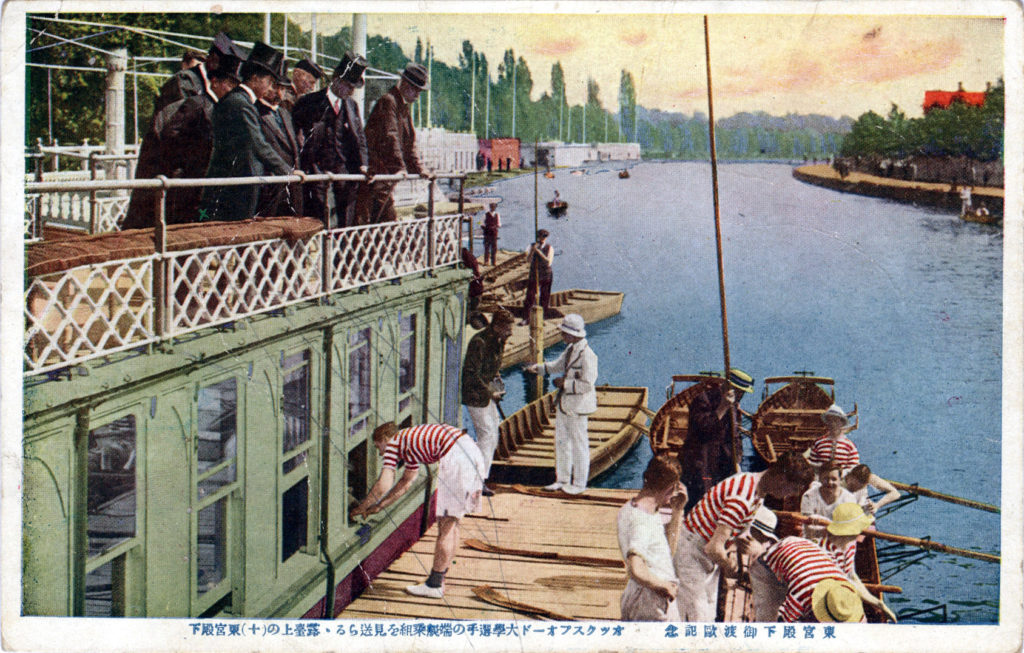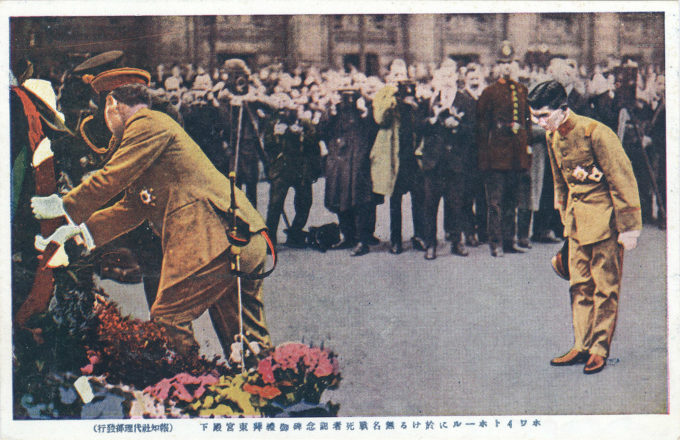See also:
Crown Prince Hirohito’s Return to Japan from Europe, 1921.
Edward Prince of Wale’s visit to Japan, 1922.
Anglo-Japanese Alliance, c. 1905
“While Hirohito’s European sojourn thus marked another important symbol of Japan’s new status as a world power, it focused, in particular, upon the most critical immediate lesson of [World War I]. As Vice Minister Ishihara noted even before trumpeting Japan’s new status [as a world power], following his trip to Britain the crown prince would tour all areas of the continent most directly affected by the war.
“The visit had, in fact, been moved up on the calendar so that the prince could see the ‘raw remnants of wartime devastation’ as soon as possible after the end of hostilities. Hirohito’s well-publicized six-month tour of Europe, in other words, marked the most powerful expression of a new official sponsorship of peace in 1920s Japan.
“At the threshold of Europe, Malta, Hirohito acknowledged the tragic losses of the war by first visiting the graves of seventy-seven Japanese sailors who had perished hunting German U-boats in the Mediterranean. In Edinburgh, he told an assembly of boy scouts that he hoped Japan would organize a similar organization a similar institution to help maintain ‘world peace.'”
– World War I and the Triumph of a New Japan, 1919–1930, by Frederick R. Dickinson, 2013
- Crown Prince Hirohito’s European Tour, 1921. HIH’s itinerary included royal visits to each of the five countries represented here by postage stamps: Great Britain, Germany, Italy, France, and the Netherlands.
- Crown Prince Hirohito & King George, London, 1921.

A six-year-old “Wolf Cub” (of the Boy Scouts Association) welcomes Crown Prince Hirohito to England, 1921. The Boy Scouts of Japan would be formed in 1922, a dozen years after General Nogi Maresuke had been introduced to the founder of Boy Scouts, General Robert Baden-Powell, at the coronation of King George V.
“In March 1921 Hirohito, accompanied by a large retinue, set off for a tour of Europe. The event was unprecedented, for it was the first time a crown prince of Japan had visited abroad. Although Hirohito traveled in France, the Netherlands, and Italy, his visit to England made the deepest impression on him. He was attracted by the freedom and informality of the English royal family. On Hirohito’s first day at Buckingham Palace, King George V paid him an unexpected breakfast visit in suspenders and carpet slippers, and Edward, Prince of Wales, played golf with him and accompanied him on a round of official gatherings.
Crown Prince Hirohito’s destinations in Europe during his six-month 1921 tour included Great Britain, France, the Netherlands, Belgium, and Italy.
“Late in his life, Hirohito would describe his visit to England as the happiest time of his life. In England he felt freedom from all the rigors and stiffness of court life in Japan. He was impressed by the relative informality of England’s royal family. He felt that King George V was treating him like a son. He observed the mixture of casual attitude and affection that the English people had for their king – rather than the awe that the Japanese had toward their emperor. And he observed the freedom that the British press had in publishing matters related to the royal family – a freedom that went as far as slander.
“On November 25, 1921, shortly after his return to Japan, Hirohito was appointed to serve as regent for his father, who had begun to show increasing signs of mental derangement.”
– Wikipedia
“In 1921, Crown Prince Hirohito became the first member of the Imperial family to leave Japanese soil; the year his name first appears in the ledgers of [clothier] Henry Poole & Co. On 3rd of March 1921, Prince Hirohito boarded a 16,000-ton battleship destined for a state visit to Britain and a tour of continental Europe. He would remember the six-month trip as the happiest time in his life.
“The Prince, presumably on the advice of the Palace, the British Ambassador or the Foreign Office, cabled Henry Poole & Co who dispatched a company representative to Gibraltar to meet the Prince’s ship. The man from Poole measured him up and cable back instructions to Savile Row to tailor a Western wardrobe in time for Prince Hirohito’s arrival in London. Prince Hirohito was subsequently photographed with the then Prince of Wales (later Edward VIII) at St James’s Palace wearing immaculately tailored Henry Poole & Co white tie and tails.
“Poole’s order books record the Crown Prince lodging at Chesterfield House (since demolished) and Buckingham Palace. His orders include the uniforms of a Lieutenant Colonel in the Japanese Navy and a Major of the Japanese Army as well as civilian clothes such as tweed three-piece golfing suits, white flannel trousers, dinner suits and the blue robe and hood of Edinburgh University who awarded him an honorary doctorate in 1923.”
“Crown Prince Hirohito traveled through Europe for six months, from March 3 to September 3, 1921. He stayed mainly in England and France, but he also made visits, of about one week each, to Belgium, the Netherlands, and Italy.
“… [The] trip to Europe turned out to be a life-changing experience for the young crown prince. He celebrated his twentieth birthday near Gibraltar on April 29, 1921, on the naval ship Katori, on the voyage to England. In numerous press interviews during the postwar years, whenever asked about the most memorable event of his life, Emperor Hirohito always mentioned his 1921 trip to Europe. He also said he considered his visit to King George V and the British royal family the most valuable lesson of the trip. As the emperor later said, ‘George V intimately explained to me the British constitutional monarchy as it ought to be. Ever since, it has been always on my mind and I have been constantly thinking about how a monarch under a constitutional monarch should behave.’
“If the primary objective of this trip, as far as Prime Minister Hara and the genro [lit. ‘principal elders’, the retired elder Japanese statesmen considered the ‘founding fathers’ of modern Japan] were concerned, was to educate the crown prince about the reality of world politics and about Japan’s relations with the Western powers, then it seems the trip was partly successful.
“Under the guidance of Baron Chinda Sutemi, one of the most experienced diplomats in Japan, Crown Prince Hirohito not only absorbed the lessons of the devastating Great War (fought only three years previously in Europe) but also learned to appreciate the importance of international peace. Looking over the ruins of the Battle of Verdun in France, where more than two million soldiers perished, Hirohito was recorded to have said, ‘War is such a terrible thing.’
“… At a personal level, however, what seems to have most impressed Crown Prince Hirohito were the extraordinary circumstances that allowed him to enjoy the experience of ‘freedom’. Comparing himself to a bird in a cage, Hirohito was delighted to be able to read entire newspapers instead of only clippings. He was so thrilled to be able to ride the Paris subway that he brought back the subway ticket to Japan, where he saved it as a memento in his study’s desk drawer in the imperial palace.”
– Emperor Hirohito and the Pacific War, by Noriko Kawamura, 2016
- Crown Prince Hirohito with the Lord Mayor of London and Edward Prince of Wales, 1921.
- Crown Prince Hirohito laying wreath at the Great War memorial [cenotaph], Whitehall, London, 1921.
More information: Hirohito in Europe: 100 years on, historic imperial trip celebrated for its vision of peace (The Japan Times)















